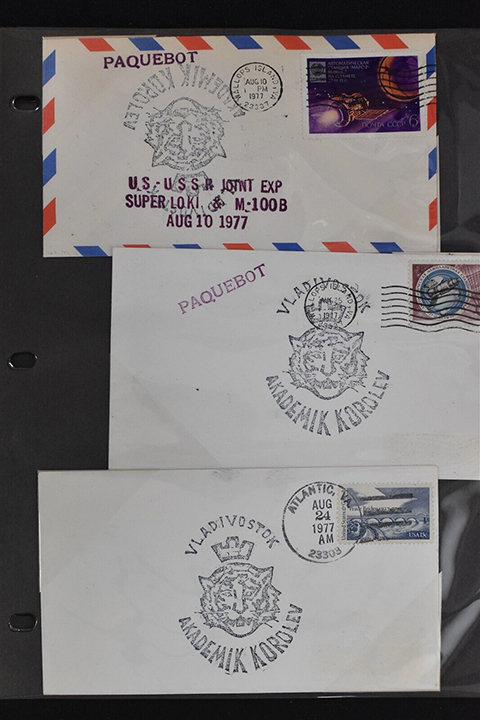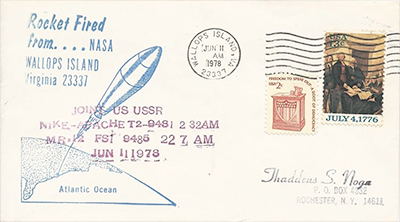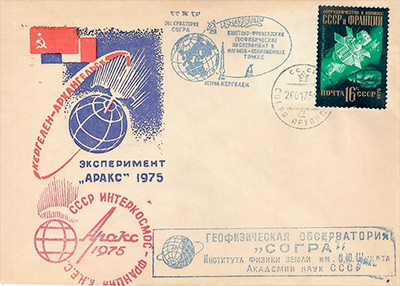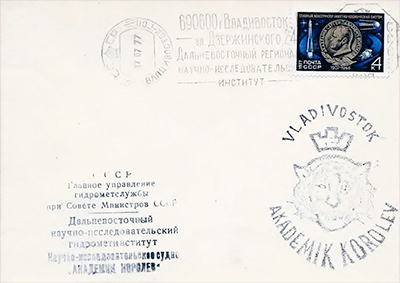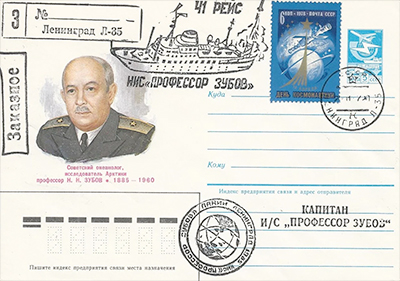Space Cover 672: Russian Launches at Wallops IslandRockets have been launched from ships since the beginning of the Space Age including a launch of a V-2 rocket from the deck of the USS Midway in 1947. However, most rockets launched from ships are more of the classification of a sounding rocket. For the United States ships the main ships known by collectors are the USS Norton Sound with many launches in the 1950s from various places around the world and the USNS Croatan which launched rockets — rockets used: Nike Apache, Nike Cajun, Arcas, Loki and Dart — from the "Wallops Mobile Launch Facility" in 1964 and 1965.
In the 1977 and 1978 ships from the Soviet Union came to the Wallops Island range for a series of launches for meteorological studies to obtain a better understanding of discrepancies in United States and Soviet meteorological rocket data of the Eastern and Western Hemispheres. The purpose of the intercomparison tests was to improve the comparability of the thermodynamic and wind measurements taken by the U.S. Super Loki Datasonde and the U.S.S.R. M-100B meteorological rocketsonde system.
The first intercomparison tests were held in August 1977 at Wallops Island. The Soviet hydrometeorological service scientific research ship Akademik Korolev participated on the Soviet side.
To carry out these tests, the Soviet hydrometeorological research vessel was stationed just off the coast of the Eastern shore to fire rockets in conjunction with those fired from the NASA Wallops Flight Center. In all, twenty-two pairs of simultaneous launchings were accomplished. These sounding rocket activities received support from the range instrumentation at Wallops Flight Center.
The rocket launches took place from August 10th to August 24th. Covers exist for these launches from Wallops Island as all launches from Wallops Island were covered by the cover service of Postmaster William Hudson and others created by Space Voyage Cachets by Robert Rank. Harder to find are the interesting "paquebot" covers with official cachets from the Russian ship Akademik Korolev. Covers are known to exist for the start and end dates of the period (August 10 and August 25) with Wallops Island postmarks. While covers also exist with US postage for the actual last launch date of August 24th from Atlantic, Virginia.
Paquebot is a postmark stamped on mail posted at sea or in a harbor for processing by the postal authorities at the next port of call. Mail so marked in one country will often carry the stamps of another country. In this case, the Akademik Korolev applied their official cachet on envelopes with Russian stamps which were then postmarked at the Wallops Island post office.
Other intercomparison tests with the Soviets using sounding rockets were conducted at Wallops Island. In June 1978, the Soviet research ship Professor Vize anchored just outside Wallops Island and participated in a Joint American-Soviet Particle Calibration (JASPIC) rocket project.
The ultimate aim of the program was to determine whether the nighttime E-region of the ionosphere between 100 and 180 km is due to incoming particles or to solar ultraviolet radiation scattered back by the outer layers of the Earth's atmosphere.
For JASPIC five Soviet MR-12 rockets were fired from the research ship; three U.S. rockets were fired from Wallops Island. A fourth U.S. payload was reserved for a period of higher geomagnetic activity.
Comparisons of data show satisfactory agreement between the different techniques used by the Soviet and U.S. scientists, indicating that a good foundation has been laid for future studies.
Again, covers were made by the Wallops Island servicer and by Space Voyage Cachets. I believe paquebot covers exist from the Professor Vize but I do not have any. Anyone have one they can post?











